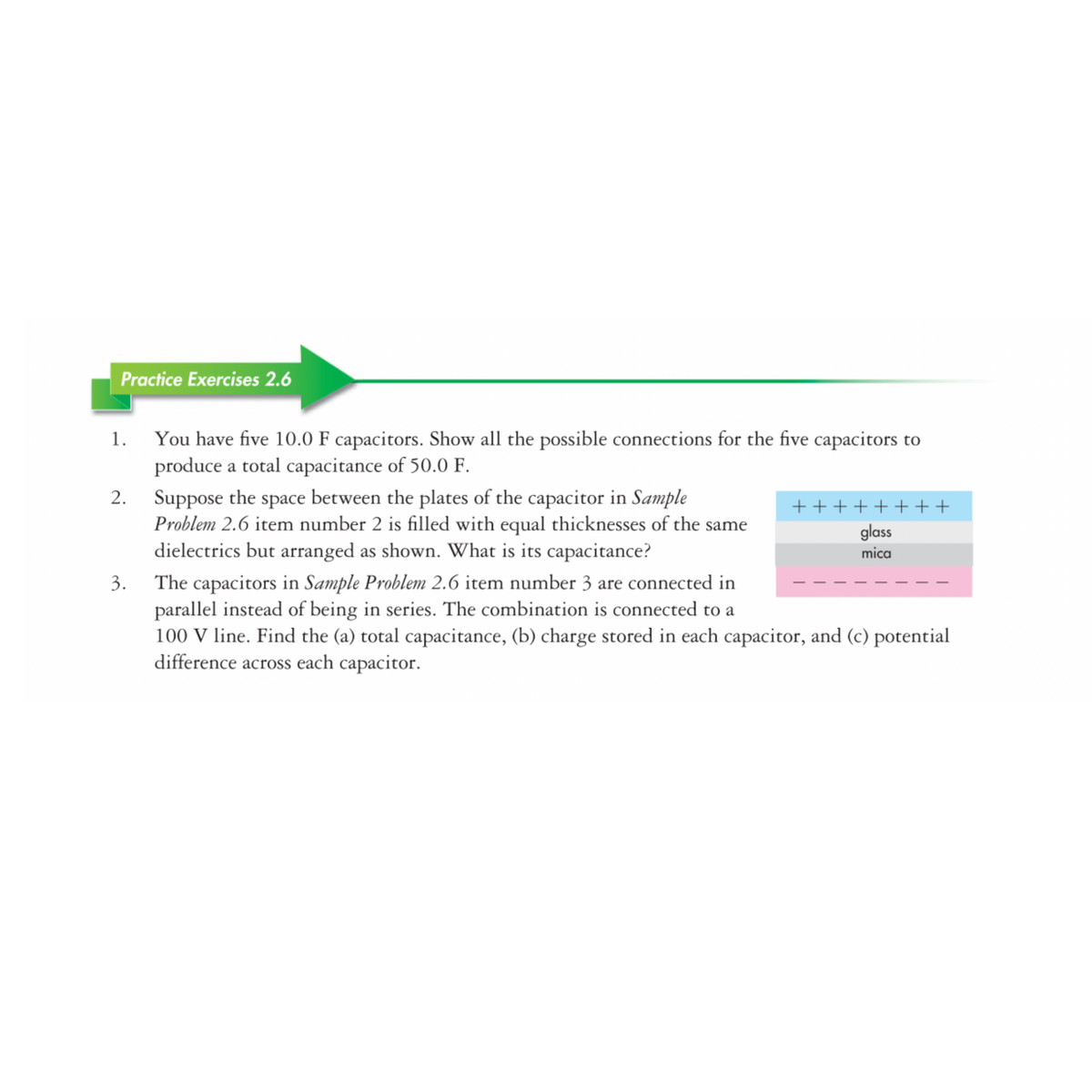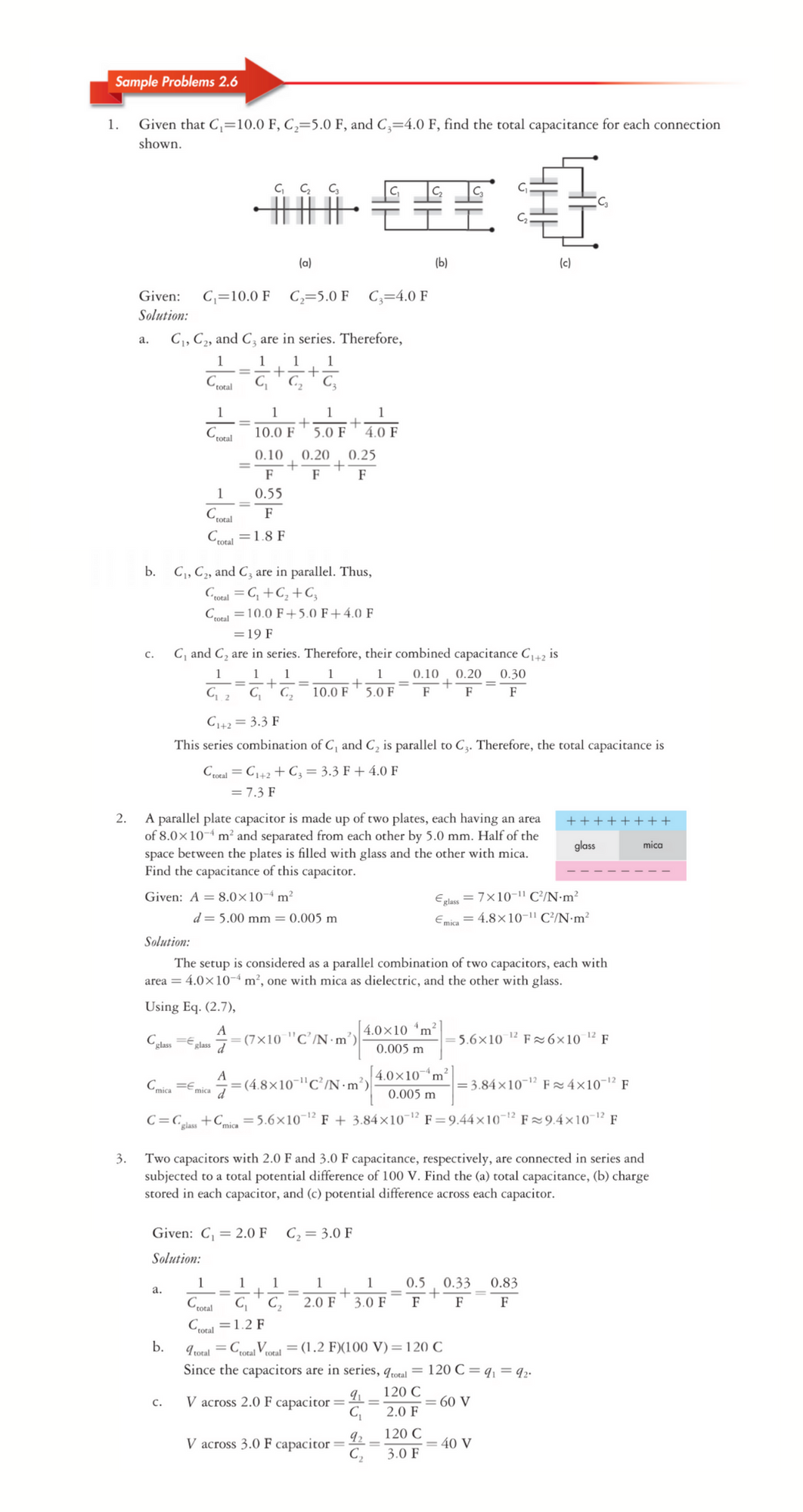e capacitors in Sample Problem 2.6 item number 3 are connected in parallel instead of being in series. The combination is connected to a 100 V line. Find the (a) total capacitance, (b) charge stored in each capacitor, and (c) potential difference across each capa
e capacitors in Sample Problem 2.6 item number 3 are connected in parallel instead of being in series. The combination is connected to a 100 V line. Find the (a) total capacitance, (b) charge stored in each capacitor, and (c) potential difference across each capa
University Physics Volume 1
18th Edition
ISBN:9781938168277
Author:William Moebs, Samuel J. Ling, Jeff Sanny
Publisher:William Moebs, Samuel J. Ling, Jeff Sanny
Chapter1: Units And Measurement
Section: Chapter Questions
Problem 15P: Use the orders of magnitude you found in the previous problem to answer the following questions to...
Related questions
Question
The capacitors in Sample Problem 2.6 item number 3 are connected in parallel instead of being in series. The combination is connected to a 100 V line. Find the (a) total capacitance, (b) charge stored in each capacitor, and (c) potential difference across each capacitor.

Transcribed Image Text:Practice Exercises 2.6
1. You have five 10.0 F capacitors. Show all the possible connections for the five capacitors to
produce a total capacitance of 50.0 F.
Suppose the space between the plates of the capacitor in Sample
Problem 2.6 item number 2 is filled with equal thicknesses of the same
dielectrics but arranged as shown. What is its capacitance?
2.
++++++++
glass
mica
3. The capacitors in Sample Problem 2.6 item number 3 are connected in
parallel instead of being in series. The combination is connected to a
100 V line. Find the (a) total capacitance, (b) charge stored in each capacitor, and (c) potential
difference across each capacitor.

Transcribed Image Text:Sample Problems 2.6
1.
Given that C,=10.0 F, C,=5.0 F, and C;=4.0 F, find the total capacitance for each connection
shown.
(a)
(Ь)
(c)
Given:
C,=10.0 F C,=5.0 F C;=4.0 F
Solution:
C,, C2, and C, are in series. Therefore,
а.
1
1
1
1
Crotal
C,
C,
1
1
1
1
Cotal
4.0 F
10.0 F
5.0 F
0.10
0.20
0.25
F
F
1
0.55
F
Cotal
Cal =1.8 F
b.
C,, C2, and C3 are in parallel. Thus,
Croual = G, +C, +C,
total
Ctal =10.0 F+5.0 F+4.0 F
=19 F
C, and C, are in series. Therefore, their combined capacitance C+2 is
C.
1
1
1
1
0.10
0.20
0.30
C2
10.0 F
5.0 F
F
F
F
C+2 = 3.3 F
This series combination of C, and C, is parallel to C3. Therefore, the total capacitance is
Croral = C+2 + C; = 3.3 F + 4.0 F
= 7.3 F
A parallel plate capacitor is made up of two plates, each having an area
of 8.0×10-4 m² and separated from each other by 5.0 mm. Half of the
space between the plates is filled with glass and the other with mica.
Find the capacitance of this capacitor.
2.
++++++++
glass
mica
Eglass = 7x10-" C?/N•m?
Emica = 4.8×10-1" C²/N•m²
Given: A = 8.0×10-4 m²
d= 5.00 mm = 0.005 m
Solution:
The setup is considered as a parallel combination of two capacitors, each with
area = 4.0×10-“ m², one with mica as dielectric, and the other with glass.
Using Eq. (2.7),
A
(7×10 "C’/N ·m’)
4.0x10 m?
= 5.6×10 1² F 26×10 ² F
Cglass Eglass
0.005 m
4.0×10n
'm²
= 3.84×10¬1² F 4×10¯1² F
A
Cmica =E,
= (4.8×10"C’/N -n
2 /N•m³)
Fmica 7
0.005 m
C=C_
+Cia = 5.6×10¬1² F + 3.84×10-1² F=9.44×10¬1² F=9.4×10-1² F
"glass
Two capacitors with 2.0 F and 3.0 F capacitance, respectively, are connected in series and
subjected to a total potential difference of 100 V. Find the (a) total capacitance, (b) charge
stored in each capacitor, and (c) potential difference across each capacitor.
3.
Given: C, = 2.0 F
C2 = 3.0 F
Solution:
1
1
1
1
1
0.5
0.33
0.83
a.
Ccotal
C ' C,
2.0 F
3.0 F
F
F
F
Ccotal =1.2 F
"A"
I rotal = Cotal Vcoral = (1.2 F)(100 V)=120 C
Since the capacitors are in series, qotal = 120 C=q, = q2.
b.
120 C
V across 2.0 F capacitor =
= 60 V
с.
2.0 F
120 C
V across 3.0 F capacitor =-
C,
= 40 V
3.0 F
Expert Solution
This question has been solved!
Explore an expertly crafted, step-by-step solution for a thorough understanding of key concepts.
This is a popular solution!
Trending now
This is a popular solution!
Step by step
Solved in 2 steps

Knowledge Booster
Learn more about
Need a deep-dive on the concept behind this application? Look no further. Learn more about this topic, physics and related others by exploring similar questions and additional content below.Recommended textbooks for you

University Physics Volume 1
Physics
ISBN:
9781938168277
Author:
William Moebs, Samuel J. Ling, Jeff Sanny
Publisher:
OpenStax - Rice University

Classical Dynamics of Particles and Systems
Physics
ISBN:
9780534408961
Author:
Stephen T. Thornton, Jerry B. Marion
Publisher:
Cengage Learning

University Physics Volume 1
Physics
ISBN:
9781938168277
Author:
William Moebs, Samuel J. Ling, Jeff Sanny
Publisher:
OpenStax - Rice University

Classical Dynamics of Particles and Systems
Physics
ISBN:
9780534408961
Author:
Stephen T. Thornton, Jerry B. Marion
Publisher:
Cengage Learning